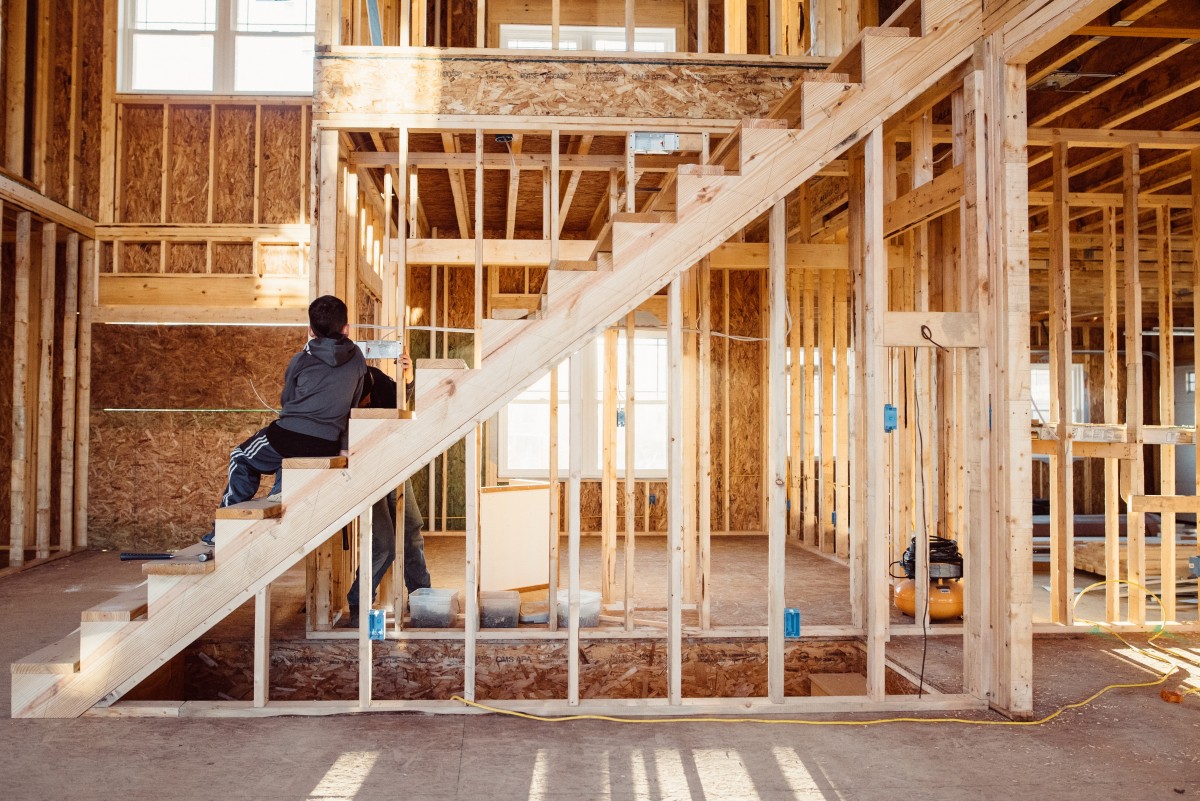4 Popular Types of Wood Construction
- Wooden frame house
- Solid wood house
- Post and beam wood house
- Solid panel house
1. Timber frame house
The wood frame is the primary wood construction technique, far ahead of post and beam, stacked solid wood and solid wood panels. Nearly 90% of wooden houses are now built using this method.
Principle of the timber frame house
The principle of the wood frame is to make a regular grid of horizontal and vertical wood pieces. This structure will be responsible for carrying the roofs and floors. The space between each upright is then filled with insulation plates, which allows keeping the interior volume of the rooms. Depending on preference, the exterior cladding can be plaster, stone, brick, or wood.
Advantages of the wood frame for a house
Here are the main advantages of the framework of a wooden house:
- The wood frame is an easy technique to implement on all types of land (landlocked, flat, unstable …).
- The structure elements are generally pre-cut and assembled in a workshop or factory to save time.
- Lightweight, the wood panels and posts are easily transported and assembled in just a few weeks. This saves time and labor!
- Wood frame walls are thin: with an average thickness of 20 cm, they offer more living space.
In addition to its technical qualities, the wood frame allows great architectural freedom not only for a vacation home!
Wooden frame house: a bioclimatic house
One of the strong points of the wood frame house of a bioclimatic house is the thermal comfort it provides, thanks to:
- air gap between the facings and the frame;
- insulation in the thickness of the studs;
- low inertia of the wood, which allows it to reach a high temperature quickly;
- absence of thermal bridges;
- nature of the wood, which regulates the ambient hygrometry.
On average, wood framing offers a 20% saving in heating costs all year round!
2. Solid wood house
The stacked solid wood is part of the 4 main construction techniques of wooden houses with the wooden frame, the posts-beams, and the solid wood panels.
Stacked log homes are the oldest construction technique. Widely used in North America, this technique is well known in mountainous regions: cottages are an example of its realization. However, this method tends to be modernized. It is estimated that 12% of wooden houses are stacked solid wood houses.
Wooden house: the principle of stacked solid wood
The technique of stacked log houses consists of building solid wood walls by a horizontal stacking process. There are different systems:
- The flat plank, which offers a rectangular finish: a plank of wood with a large section, is shaped in a tough species (e.g., oak) and presents an aesthetic consistent with solid wood construction while adopting a contemporary line.
- The half-round plank is more rustic. It offers the interest of facilitating the interior arrangement thanks to the flat sectioned face.
- The log or round wood corresponds to the most classic architecture of the solid wood house. It is used in the construction of cottages.
Advantages of the stacked log house
Here are the main advantages of stacked log houses: the house has excellent inertia thanks to solid wood, in logs or flat planks. The heat is retained and restored as soon as a drop in temperature occurs.
- Wood provides good thermal and acoustic insulation and natural hygrometric regulation.
- The undeniable charm of authenticity! Solid wood houses, traditional or revisited by modernity, offer a particular cachet.
- From six to ten weeks, the construction time, much longer than for a flat timber frame house, remains very interesting.
Log house: recommendations
One of the problems with stacked log construction is the possible settlement of the wood. Indeed, the nature of the wood and the technique used can cause settlement and vertical movement depending on temperature changes, which would affect the longevity of the stacked log house.
The wood pieces must fit together perfectly to perfect air and water tightness. In addition, the logs used for the exterior walls must be sufficiently protected from attack by wood-eating fungi.
3. Wooden house: post and beam
 Post and beam construction is one of the 4 main techniques for building a wooden house, along with the timber frame, stacked solid wood, and solid wood panels.
Post and beam construction is one of the 4 main techniques for building a wooden house, along with the timber frame, stacked solid wood, and solid wood panels.
The post and beam technique is less well-known than the timber frame and is directly derived from half-timbered houses. It was developed to save wood in these regions because even if the houses of this type were numerous, the forests suffered from not being replanted.
Wooden house: the principle of post and beam
The technique of post and beam is based on the use of vertical posts, responsible for supporting wooden beams arranged horizontally. Placed at regular intervals of 2 to 5 m, they form a frame maintained by interlocking systems (metal bolts, wooden keys, oak pegs).
It is a half-timbered construction where the elements have been separated (saving wood). The space left free is filled with concrete, glass, stone, or planks.
Advantages of post-and-beam construction
Here are the main advantages of post and beam for a wooden house:
The load-bearing structure, made of solid wood, glued laminated timber (a substantial assembly of several strips from the heart of several kinds of wood), or glued, is highly robust. It is particularly resistant to settlement.
Thanks to the strength of the beams, you can create large volumes without the need for a load-bearing wall. Great architectural freedom!
Between 6 to 8 weeks, the construction time is longer than for the flat wood frame but remains very interesting compared to a traditional masonry house.
Adaptable to all terrains and regional styles, post and beam construction allows you to obtain a building permit without difficulty.
4. Wooden house: solid panels
Solid panels are one of the 4 main techniques for building a wooden house, along with the timber frame, post, beam, and stacked solid wood.
Solid panels are mainly used for large-scale constructions: offices, communities, industries, etc. But you can also use it for the construction of individual houses.
Large wooden boards are finger-jointed to obtain the necessary lengths for the laminated panels. These panels are used as elements of exterior walls, floors, and roof supports.
Wooden house: advantages of these panels
Here are the main advantages of solid panels for a wooden house:
Thanks to their large size, the panels are quickly assembled, with a minimum of waste.
The panels ensure good hygrometric regulation, non-deformable walls over time, and excellent capacity to accumulate heat and water vapor. All in all, an authentic guarantee of daily comfort.
All exterior coatings can be adopted on the panels. Likewise, the choice of insulation is completely free.
Hope this post helps you choose the type of wood construction for your home project. Remember to share your experience in the comments below.


